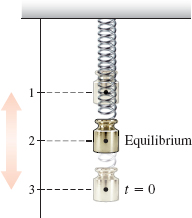EXAMPLE 6Analyzing Simple Harmonic Motion
An object hangs on a spring, making it 2 m long in its equilibrium position. See Figure 28. If the object is pulled down 1 m and released, it will oscillate up and down. The length l of the spring after t seconds is modeled by the function l(t)=2+cost.
- (a) How does the length of the spring vary?
- (b) Find the velocity of the object.
- (c) At what position is the speed of the object a maximum?
- (d) Find the acceleration of the object.
- (e) At what position is the acceleration equal to 0?
Solution
- (a) Since l(t)=2+cost and −1≤cost≤1, the length of the spring oscillates between 1 m and 3 m.
- (b) The velocity v of the object is v=l′(t)=ddt(2+cost)=−sint
- (c) Speed is the magnitude of velocity. Since v=−sint, the speed of the object is |v|=|−sint|=|sint|. Since −1≤sint≤1, the object moves the fastest when |v|=|sint|=1. This occurs when sint=±1 or, equivalently, when cost=0. So, the speed is a maximum when l(t)=2, that is, when the spring is at the equilibrium position.
- (d) The acceleration a of the object is given by a=l″
- (e) Since a=-\cos t, the acceleration is zero when \cos t=0. This occurs when l( t) =2, that is, when the spring is at the equilibrium position. At this time, the speed is maximum.


